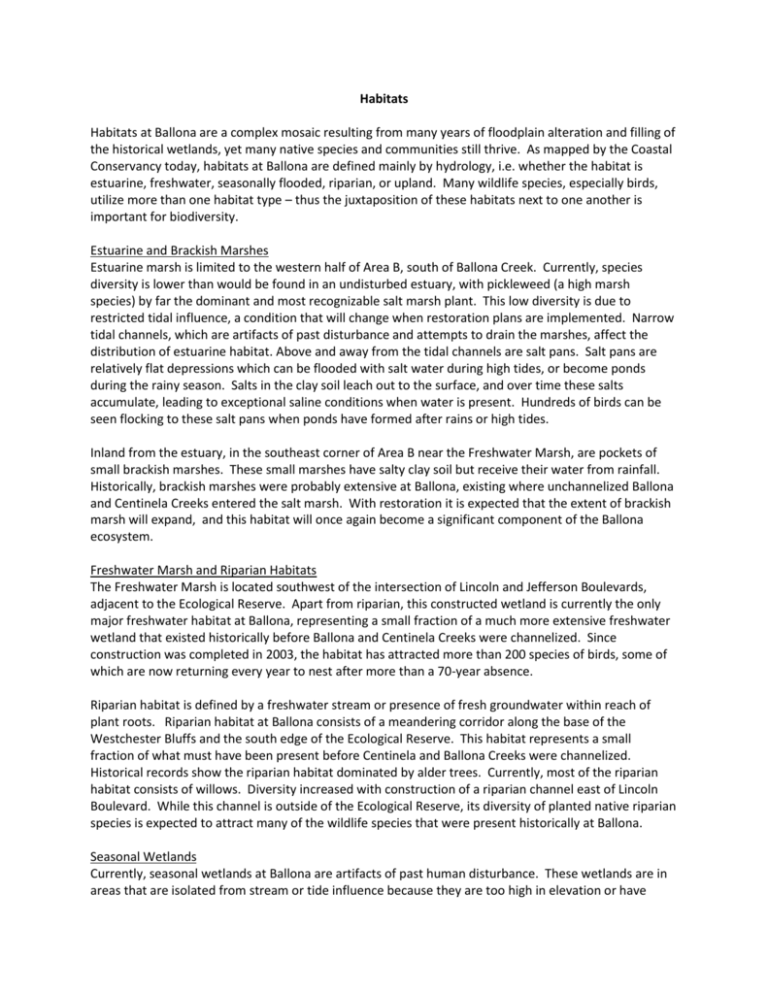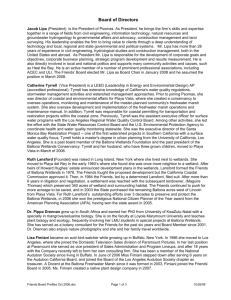05 Habitat - Friends of Ballona Wetlands
advertisement

Habitats Habitats at Ballona are a complex mosaic resulting from many years of floodplain alteration and filling of the historical wetlands, yet many native species and communities still thrive. As mapped by the Coastal Conservancy today, habitats at Ballona are defined mainly by hydrology, i.e. whether the habitat is estuarine, freshwater, seasonally flooded, riparian, or upland. Many wildlife species, especially birds, utilize more than one habitat type – thus the juxtaposition of these habitats next to one another is important for biodiversity. Estuarine and Brackish Marshes Estuarine marsh is limited to the western half of Area B, south of Ballona Creek. Currently, species diversity is lower than would be found in an undisturbed estuary, with pickleweed (a high marsh species) by far the dominant and most recognizable salt marsh plant. This low diversity is due to restricted tidal influence, a condition that will change when restoration plans are implemented. Narrow tidal channels, which are artifacts of past disturbance and attempts to drain the marshes, affect the distribution of estuarine habitat. Above and away from the tidal channels are salt pans. Salt pans are relatively flat depressions which can be flooded with salt water during high tides, or become ponds during the rainy season. Salts in the clay soil leach out to the surface, and over time these salts accumulate, leading to exceptional saline conditions when water is present. Hundreds of birds can be seen flocking to these salt pans when ponds have formed after rains or high tides. Inland from the estuary, in the southeast corner of Area B near the Freshwater Marsh, are pockets of small brackish marshes. These small marshes have salty clay soil but receive their water from rainfall. Historically, brackish marshes were probably extensive at Ballona, existing where unchannelized Ballona and Centinela Creeks entered the salt marsh. With restoration it is expected that the extent of brackish marsh will expand, and this habitat will once again become a significant component of the Ballona ecosystem. Freshwater Marsh and Riparian Habitats The Freshwater Marsh is located southwest of the intersection of Lincoln and Jefferson Boulevards, adjacent to the Ecological Reserve. Apart from riparian, this constructed wetland is currently the only major freshwater habitat at Ballona, representing a small fraction of a much more extensive freshwater wetland that existed historically before Ballona and Centinela Creeks were channelized. Since construction was completed in 2003, the habitat has attracted more than 200 species of birds, some of which are now returning every year to nest after more than a 70-year absence. Riparian habitat is defined by a freshwater stream or presence of fresh groundwater within reach of plant roots. Riparian habitat at Ballona consists of a meandering corridor along the base of the Westchester Bluffs and the south edge of the Ecological Reserve. This habitat represents a small fraction of what must have been present before Centinela and Ballona Creeks were channelized. Historical records show the riparian habitat dominated by alder trees. Currently, most of the riparian habitat consists of willows. Diversity increased with construction of a riparian channel east of Lincoln Boulevard. While this channel is outside of the Ecological Reserve, its diversity of planted native riparian species is expected to attract many of the wildlife species that were present historically at Ballona. Seasonal Wetlands Currently, seasonal wetlands at Ballona are artifacts of past human disturbance. These wetlands are in areas that are isolated from stream or tide influence because they are too high in elevation or have been cut off from natural surface water sources. These wetlands have formed in small depressions and depend entirely on rainfall as a source of water. Due to soil salinity, pickleweed (normally a salt marsh plant) tends to dominate these wetlands. Uplands The Coastal Conservancy’s habitat map is limited to the Ecological Reserve. Adjacent to (and south of) the Ecological Reserve is an important upland habitat called coastal sage scrub, along the face of the Westchester Bluffs. Another important upland native habitat at Ballona is the Dunes, located on the west side of Area B. The Dunes have been a major focus of restoration by the Friends of Ballona Wetlands. Elsewhere within the Ecological Reserve, most upland areas have been invaded by nonnative species and do not fit any standard habitat classification. Management and control of these nonnative species, and their replacement with native habitat, will be one of the goals of restoration.








